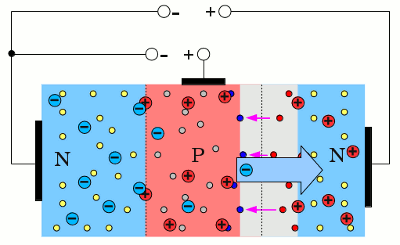بخش دیود تونل (Tunnel diode) _ بسیار رسانا و بسیار پر فشار
جریان الکتریکی در دیود تونل (Tunnel diode)
پژوهشگر و نویسنده: دکتر ( افشین رشید )


نکته : دیود تونل (Tunnel diode) معمولی تنها در صورتی جریان الکتریکی تولید می کند که ولتاژ اعمال شده بیشتر از ولتاژ داخلی منطقه تخلیه باشد.مکانیک کوانتومی می گوید که اگر عرض تخلیه بسیار کوچک باشد، الکترون ها مستقیماً از لایه تخلیه یا مانع نفوذ می کنند.
لایه تخلیه دیود تونل بسیار کوچک است. بر حسب نانومتر است. بنابراین الکترون ها می توانند مستقیماً در سراسر ناحیه تخلیه کوچک از نوار رسانایی سمت مثبت به نوار ظرفیت سمت منفی تونل بزنند.در دیود های معمولی، جریان زمانی تولید می شود که ولتاژ اعمال شده بیشتر از ولتاژ داخلی منطقه تخلیه باشد. اما در دیود های تونلی، ولتاژ کوچکی که کمتر از ولتاژ داخلی منطقه تخلیه است، برای تولید جریان الکتریکی کافی است.در دیود های تونلی، الکترون ها برای تولید جریان الکتریکی نیازی به غلبه بر نیروی مخالف لایه تخلیه ندارند. الکترون ها می توانند مستقیماً از نوار رسانایی ناحیه مثبت به نوار ظرفیت ناحیه منفی تونل بزنند. بنابراین جریان الکتریکی در دیود تونلی تولید می شود.
_i59w.gif)
در ساختار یک دیود تونل ، یک ذره باید دارای انرژی حداقل برابر با ارتفاع یک مانع احتمالی باشد ، اگر از یک طرف به طرف دیگر منتقل شود. احتمال زیادی برای نفوذ الکترون به الکترون وجود دارد. مانع. این رفتار مکانیکی کوانتوم به عنوان تونل سازی شناخته می شود و از این رو این دستگاه های اتصال pn با تراکم ناخالصی های بالا ( دیود های تونل ) نامیده می شوند.

_lqw5.gif)
دیود تونلی یک نوع دیود حفاظتی است که قابلیت عملکرد بسیار سریع در حد فرکانس های ریز موج را داراست. این دیود بر پایهٔ اثر تونل زنی در مکانیک کوانتومی کار می کند. دیود های تونلی کاربرد های خود به را تا حد زیادی به FET ها داده اند. با وجود اینکه دیود های تونلی همچنان در مدارهای آشکار ساز کاربرد گسترده ای دارند، ولی در زمینهٔ تقویت کنندگی که نیاز به خطی بودن مشخصه است، تکنولوژی های جایگزینی مثل گالیم آرسنید و سیلیکون – ژرمانیوم گسترش بیشتری یافته اند.
پژوهشگر و نویسنده: دکتر ( افشین رشید)
دکترایِ تخصصی نانو _ میکرو الکترونیک

